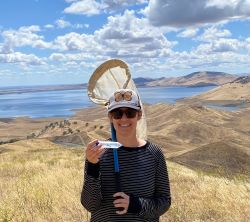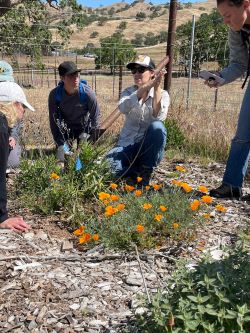Sardiñas surveying Asclepias californica, an early season milkweed species, on Mt Diablo (credit: Ling He/NRCS).

Surveying for bumble bees in Upper Cottonwood Creek Reserve (credit: Lara Sparks/CDFW)

Sardiñas leading a field training at the Bay Area Grassland Butterfly Symposium.
As CDFW’s statewide pollinator coordinator, Dr. Hillary Sardiñas supports conservation related to bees, monarch butterflies and any other animal in California that transfers pollen between plants to help them reproduce. She works with a variety of partners, including nonprofit organizations and state and federal agencies to come up with new ideas and collaborations for improving pollinator conservation.
Sardiñas earned her undergraduate degree in environmental studies from University of California, Santa Cruz. She went on to study at the graduate level, earning a Ph.D. in environmental policy and management from University of California, Berkeley. She was hired by CDFW in January 2021.
When did you know you wanted to be a scientist?
When I was an undergrad at UC Santa Cruz I worked in the Chadwick Garden, a small organic garden perched above the hills of Santa Cruz. I was taking a summer course on the natural history of birds and practicing my observation skills when I saw a hummingbird nab and eat a butterfly. Up until that point, I hadn’t realized that hummingbirds also ate insects, I thought they only survived on nectar. Making that connection helped me realize I wanted a career where I got to understand what was happening in nature. I started taking more ecology courses and decided to become an environmental scientist.
What was your path to grad school?
During undergrad I got to take an amazing class called Natural History Field Quarter where I traveled statewide surveying plants and animals. It got me interested in the incredible diversity in California. After I graduated, I worked for some native plant nurseries, and I did a lot of seed collection. In learning more about plants and propagation, I discovered some plants weren't producing seeds. I got curious and researched potential causes, which is how I first heard about pollinator decline and the important role pollinators play in natural and agricultural systems. I realized I wanted to work to protect pollinators. I decided to go to grad school to study how to restore pollinator habitat.
What did you do professionally before joining CDFW?
I spent some time working for the Xerces Society for Invertebrate Conservation where I had the opportunity to collaborate with farmers from all over the west, helping them design and install habitat for pollinators. From there, I joined the Alameda County Resource Conservation District (RCD) where I worked with species such as the California tiger salamander, California red-legged frog and Alameda whipsnake. I also helped create a monarch conservation program that became the model for other RCD monarch programs. I ended up working with the California Association of Resource Conservation Districts, the nonprofit partner to California’s RCDs, as their statewide monarch coordinator. In that role I was able to support dozens of RCDs in their monarch and pollinator-related outreach and restoration work.
What drew you to CDFW’s statewide pollinator coordinator position?
My dream since I was a grad student was to work at a statewide level to conserve pollinators. When I heard about this position, I knew I had to apply. The timing for this position couldn’t have been better. It has enabled CDFW to respond to the emerging monarch crisis while also protecting other important pollinators like bumble bees. Pollinators are responsible for 80 percent of all flowering plant reproduction, and 35 percent of all crops depend on pollinators. Conserving pollinators is an incredibly important issue that helps maintain ecosystem function and sustain biodiversity. In the past year and a half, I’ve been able to work at the state level to bring partners together to develop collaborative management actions that benefit pollinators.
What is your job like on a day-to-day basis?
Every day is different, which is part of the fun. But I do have a few focal areas. One of the species I work with the most is the western monarch. CDFW owns properties along the California coast that support monarch overwintering clusters, so part of my job is working to enhance these sites. I’m also helping to increase native milkweed supply from commercial nurseries so we can enhance breeding habitat.
I also support the California Bumblebee Atlas, a community science project that we’re partnering on with the Xerces Society for Invertebrate Conservation. The goal of the Atlas is to better understand the distribution and health of the state’s bumble bee species. We’re recruiting members of the public to help us survey, since the state is so large we can’t cover it by ourselves.
One of my favorite parts of this job is collaborating with other CDFW staff. For example, I assist our land managers with restoration plans and seed mixes. I also support our habitat conservation division by reviewing proposed projects that might impact pollinators and determining how we can avoid or minimize those impacts. I learn so much from all my colleagues.
How important is public outreach in your job?
Outreach is critical, in large part because the public can play a big role in supporting monarchs and other pollinators. People usually understand the importance of pollinators, but not everyone knows all the different species that contribute to pollination such as wasps and bats. I also try to emphasize the importance of other insects, as they contribute to many critical ecosystem processes. Helping people shift to overcome their fear of insects and understand the incredible role they play is important to ensuring their protection. Biologist E.O. Wilson talked about the “little things that run the world,” and I think pollinators are underrecognized for the value they provide. One way we’re working to get the word out is by installing new signs in our wildlife areas describing the role pollinators play in ecosystem function.
What can the public do to help?
Luckily the adage, “If you build it, they will come,” is true for pollinators. Planting native flowering plants creates pollinator habitat no matter where you live, whether in a city or a rural area. It's important to make sure that all plants you purchase are pesticide free so you don’t inadvertently poison the pollinators you’re trying to attract.
I also encourage people to get involved in a community science project. Community scientists help us cover this vast state. Data collected by community scientists helps us assess the status of insect populations and allows us to develop appropriate management actions. There are a ton of different community science projects with varying levels of commitment, so it’s easy to find one that’s right for you.
What advice do you have for aspiring scientists?
Stay curious. I started out with plants, then got really interested in pollinators, and even took a detour where I learned a lot about amphibians. All of these experiences and interests contributed to a more holistic understanding of the natural world. I also think having a vision is important. As I mentioned, I maintained the goal of working on pollinator conservation at the statewide level. With this objective in mind, I made sure to connect with a variety of different stakeholders and maintain those connections. I think this is what has helped me be successful in this position, because collaboration is a really effective and efficient way to accomplish a lot in a short period of time. And pollinators need as much support as possible.